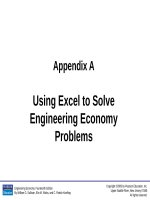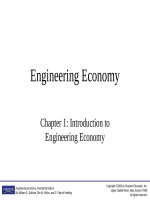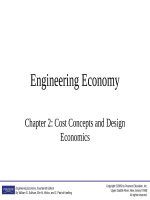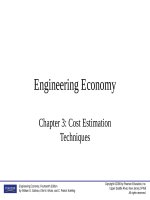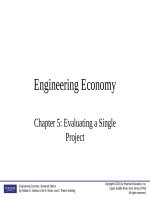Engineering economic 14th by william sullivan and koeling ch 04
Bạn đang xem bản rút gọn của tài liệu. Xem và tải ngay bản đầy đủ của tài liệu tại đây (743.15 KB, 40 trang )
Engineering Economy
Chapter 4: The Time Value of Money
Engineering Economy, Fourteenth Edition
By William G. Sullivan, Elin M. Wicks, and C. Patrick Koelling
Copyright ©2009 by Pearson Education, Inc.
Upper Saddle River, New Jersey 07458
All rights reserved.
The objective of Chapter 4 is to
explain time value of money
calculations and to illustrate
economic equivalence.
Engineering Economy, Fourteenth Edition
By William G. Sullivan, Elin M. Wicks, and C. Patrick Koelling
Copyright ©2009 by Pearson Education, Inc.
Upper Saddle River, New Jersey 07458
All rights reserved.
Money has a time value.
• Capital refers to wealth in the form of
money or property that can be used to
produce more wealth.
• Engineering economy studies involve the
commitment of capital for extended periods
of time.
• A dollar today is worth more than a dollar
one or more years from now (for several
reasons).
Engineering Economy, Fourteenth Edition
By William G. Sullivan, Elin M. Wicks, and C. Patrick Koelling
Copyright ©2009 by Pearson Education, Inc.
Upper Saddle River, New Jersey 07458
All rights reserved.
Return to capital in the form of interest and
profit is an essential ingredient of
engineering economy studies.
• Interest and profit pay the providers of capital for
forgoing its use during the time the capital is being
used.
• Interest and profit are payments for the risk the
investor takes in letting another use his or her
capital.
• Any project or venture must provide a sufficient
return to be financially attractive to the suppliers
of money or property.
Engineering Economy, Fourteenth Edition
By William G. Sullivan, Elin M. Wicks, and C. Patrick Koelling
Copyright ©2009 by Pearson Education, Inc.
Upper Saddle River, New Jersey 07458
All rights reserved.
Simple Interest: infrequently
used
When the total interest earned or charged is linearly
proportional to the initial amount of the loan
(principal), the interest rate, and the number of
interest periods, the interest and interest rate are said
to be simple.
Engineering Economy, Fourteenth Edition
By William G. Sullivan, Elin M. Wicks, and C. Patrick Koelling
Copyright ©2009 by Pearson Education, Inc.
Upper Saddle River, New Jersey 07458
All rights reserved.
Computation of simple interest
The total interest, I, earned or paid may be computed
using the formula below.
P = principal amount lent or borrowed
N = number of interest periods (e.g., years)
i = interest rate per interest period
The total amount repaid at the end of N interest
periods is P + I.
Engineering Economy, Fourteenth Edition
By William G. Sullivan, Elin M. Wicks, and C. Patrick Koelling
Copyright ©2009 by Pearson Education, Inc.
Upper Saddle River, New Jersey 07458
All rights reserved.
If $5,000 were loaned for five years at a
simple interest rate of 7% per year, the
interest earned would be
So, the total amount repaid at the end
of five years would be the original
amount ($5,000) plus the interest
($1,750), or $6,750.
Engineering Economy, Fourteenth Edition
By William G. Sullivan, Elin M. Wicks, and C. Patrick Koelling
Copyright ©2009 by Pearson Education, Inc.
Upper Saddle River, New Jersey 07458
All rights reserved.
Compound interest reflects both the remaining principal
and any accumulated interest. For $1,000 at 10%…
Period
1
(1)
(2)=(1)x10%
Amount owed
Interest
at beginning of amount for
period
period
$1,000
$100
(3)=(1)+(2)
Amount
owed at end
of period
$1,100
2
$1,100
$110
$1,210
3
$1,210
$121
$1,331
Compound interest is commonly used in personal and
professional financial transactions.
Engineering Economy, Fourteenth Edition
By William G. Sullivan, Elin M. Wicks, and C. Patrick Koelling
Copyright ©2009 by Pearson Education, Inc.
Upper Saddle River, New Jersey 07458
All rights reserved.
Economic equivalence allows us to
compare alternatives on a common basis.
• Each alternative can be reduced to an
equivalent basis dependent on
– interest rate,
– amount of money involved, and
– timing of monetary receipts or expenses.
• Using these elements we can “move” cash
flows so that we can compare them at
particular points in time.
Engineering Economy, Fourteenth Edition
By William G. Sullivan, Elin M. Wicks, and C. Patrick Koelling
Copyright ©2009 by Pearson Education, Inc.
Upper Saddle River, New Jersey 07458
All rights reserved.
We need some tools to find economic
equivalence.
• Notation used in formulas for compound interest
calculations.
– i = effective interest rate per interest period
– N = number of compounding (interest) periods
– P = present sum of money; equivalent value of one or
more cash flows at a reference point in time; the present
– F = future sum of money; equivalent value of one or
more cash flows at a reference point in time; the future
– A = end-of-period cash flows in a uniform series
continuing for a certain number of periods, starting at the
end of the first period and continuing through the last
Engineering Economy, Fourteenth Edition
By William G. Sullivan, Elin M. Wicks, and C. Patrick Koelling
Copyright ©2009 by Pearson Education, Inc.
Upper Saddle River, New Jersey 07458
All rights reserved.
A cash flow diagram is an indispensable
tool for clarifying and visualizing a
series of cash flows.
Engineering Economy, Fourteenth Edition
By William G. Sullivan, Elin M. Wicks, and C. Patrick Koelling
Copyright ©2009 by Pearson Education, Inc.
Upper Saddle River, New Jersey 07458
All rights reserved.
Cash flow tables are essential to
modeling engineering economy
problems in a spreadsheet
Engineering Economy, Fourteenth Edition
By William G. Sullivan, Elin M. Wicks, and C. Patrick Koelling
Copyright ©2009 by Pearson Education, Inc.
Upper Saddle River, New Jersey 07458
All rights reserved.
We can apply compound interest
formulas to “move” cash flows along the
cash flow diagram.
Using the standard notation, we find that a
present amount, P, can grow into a future
amount, F, in N time periods at interest rate
i according to the formula below.
In a similar way we can find P given F by
Engineering Economy, Fourteenth Edition
By William G. Sullivan, Elin M. Wicks, and C. Patrick Koelling
Copyright ©2009 by Pearson Education, Inc.
Upper Saddle River, New Jersey 07458
All rights reserved.
It is common to use standard notation for
interest factors.
This is also known as the single payment
compound amount factor. The term on the
right is read “F given P at i% interest per
period for N interest periods.”
is called the single payment present worth
factor.
Engineering Economy, Fourteenth Edition
By William G. Sullivan, Elin M. Wicks, and C. Patrick Koelling
Copyright ©2009 by Pearson Education, Inc.
Upper Saddle River, New Jersey 07458
All rights reserved.
We can use these to find economically
equivalent values at different points in time.
$2,500 at time zero is equivalent to how much after six
years if the interest rate is 8% per year?
$3,000 at the end of year seven is equivalent to how
much today (time zero) if the interest rate is 6% per
year?
Engineering Economy, Fourteenth Edition
By William G. Sullivan, Elin M. Wicks, and C. Patrick Koelling
Copyright ©2009 by Pearson Education, Inc.
Upper Saddle River, New Jersey 07458
All rights reserved.
There are interest factors for a series of
end-of-period cash flows.
How much will you have in 40 years if you
save $3,000 each year and your account
earns 8% interest each year?
Engineering Economy, Fourteenth Edition
By William G. Sullivan, Elin M. Wicks, and C. Patrick Koelling
Copyright ©2009 by Pearson Education, Inc.
Upper Saddle River, New Jersey 07458
All rights reserved.
Finding the present amount from a series
of end-of-period cash flows.
How much would is needed today to provide
an annual amount of $50,000 each year for 20
years, at 9% interest each year?
Engineering Economy, Fourteenth Edition
By William G. Sullivan, Elin M. Wicks, and C. Patrick Koelling
Copyright ©2009 by Pearson Education, Inc.
Upper Saddle River, New Jersey 07458
All rights reserved.
Finding A when given F.
How much would you need to set aside each
year for 25 years, at 10% interest, to have
accumulated $1,000,000 at the end of the 25
years?
Engineering Economy, Fourteenth Edition
By William G. Sullivan, Elin M. Wicks, and C. Patrick Koelling
Copyright ©2009 by Pearson Education, Inc.
Upper Saddle River, New Jersey 07458
All rights reserved.
Finding A when given P.
If you had $500,000 today in an account
earning 10% each year, how much could you
withdraw each year for 25 years?
Engineering Economy, Fourteenth Edition
By William G. Sullivan, Elin M. Wicks, and C. Patrick Koelling
Copyright ©2009 by Pearson Education, Inc.
Upper Saddle River, New Jersey 07458
All rights reserved.
It can be challenging to solve for N or i.
• We may know P, A, and i and want to find
N.
• We may know P, A, and N and want to find
i.
• These problems present special challenges
that are best handled on a spreadsheet.
Engineering Economy, Fourteenth Edition
By William G. Sullivan, Elin M. Wicks, and C. Patrick Koelling
Copyright ©2009 by Pearson Education, Inc.
Upper Saddle River, New Jersey 07458
All rights reserved.
Finding N
Acme borrowed $100,000 from a local bank, which
charges them an interest rate of 7% per year. If Acme
pays the bank $8,000 per year, now many years will it
take to pay off the loan?
So,
This can be solved by using the interest tables and
interpolation, but we generally resort to a computer
solution.
Engineering Economy, Fourteenth Edition
By William G. Sullivan, Elin M. Wicks, and C. Patrick Koelling
Copyright ©2009 by Pearson Education, Inc.
Upper Saddle River, New Jersey 07458
All rights reserved.
Finding i
Jill invested $1,000 each year for five years in a local
company and sold her interest after five years for
$8,000. What annual rate of return did Jill earn?
So,
Again, this can be solved using the interest tables
and interpolation, but we generally resort to a
computer solution.
Engineering Economy, Fourteenth Edition
By William G. Sullivan, Elin M. Wicks, and C. Patrick Koelling
Copyright ©2009 by Pearson Education, Inc.
Upper Saddle River, New Jersey 07458
All rights reserved.
There are specific spreadsheet functions
to find N and i.
The Excel function used to solve for N is
NPER(rate, pmt, pv), which will compute the
number of payments of magnitude pmt required to
pay off a present amount (pv) at a fixed interest
rate (rate).
One Excel function used to solve for i is
RATE(nper, pmt, pv, fv), which returns a fixed
interest rate for an annuity of pmt that lasts for nper
periods to either its present value (pv) or future value
(fv).
Engineering Economy, Fourteenth Edition
By William G. Sullivan, Elin M. Wicks, and C. Patrick Koelling
Copyright ©2009 by Pearson Education, Inc.
Upper Saddle River, New Jersey 07458
All rights reserved.
We need to be able to handle cash
flows that do not occur until
some time in the future.
• Deferred annuities are uniform series that
do not begin until some time in the future.
• If the annuity is deferred J periods then the
first payment (cash flow) begins at the end
of period J+1.
Engineering Economy, Fourteenth Edition
By William G. Sullivan, Elin M. Wicks, and C. Patrick Koelling
Copyright ©2009 by Pearson Education, Inc.
Upper Saddle River, New Jersey 07458
All rights reserved.
Finding the value at time 0 of a
deferred annuity is a two-step
process.
1. Use (P/A, i%, N-J) find the value of the
deferred annuity at the end of period J
(where there are N-J cash flows in the
annuity).
2. Use (P/F, i%, J) to find the value of the
deferred annuity at time zero.
Engineering Economy, Fourteenth Edition
By William G. Sullivan, Elin M. Wicks, and C. Patrick Koelling
Copyright ©2009 by Pearson Education, Inc.
Upper Saddle River, New Jersey 07458
All rights reserved.




